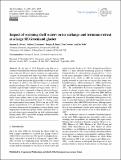Files in this item
Impact of warming shelf waters on ice mélange and terminus retreat at a large SE Greenland glacier
Item metadata
| dc.contributor.author | Bevan, Suzanne | |
| dc.contributor.author | Luckman, Adrian | |
| dc.contributor.author | Benn, Douglas I. | |
| dc.contributor.author | Cowton, Tom | |
| dc.contributor.author | Todd, Joe | |
| dc.date.accessioned | 2019-09-19T08:30:07Z | |
| dc.date.available | 2019-09-19T08:30:07Z | |
| dc.date.issued | 2019-09-05 | |
| dc.identifier | 260404300 | |
| dc.identifier | 22869638-0e65-4794-9204-c7ea3f8c0a0a | |
| dc.identifier | 85072014135 | |
| dc.identifier | 000484495000002 | |
| dc.identifier.citation | Bevan , S , Luckman , A , Benn , D I , Cowton , T & Todd , J 2019 , ' Impact of warming shelf waters on ice mélange and terminus retreat at a large SE Greenland glacier ' , The Cryosphere , vol. 13 , pp. 2303-2315 . https://doi.org/10.5194/tc-13-2303-2019 | en |
| dc.identifier.issn | 1994-0416 | |
| dc.identifier.other | ORCID: /0000-0003-1668-7372/work/61979024 | |
| dc.identifier.other | ORCID: /0000-0002-3604-0886/work/64697396 | |
| dc.identifier.other | ORCID: /0000-0003-3183-043X/work/65014586 | |
| dc.identifier.uri | https://hdl.handle.net/10023/18508 | |
| dc.description | The research under project CALISMO (Calving Laws for Ice Sheet Models) was funded by the Natural Environment Research Council (NERC) grants NE/P011365/1. TanDEM-X data used for generating the DEMs and for ice-front positions and glacier velocities 5 were supplied by DLR, as part of NERC project NE/I0071481/1. | en |
| dc.description.abstract | By the end of 2018 Kangerlussuaq Glacier in southeast Greenland had retreated further inland than at any time in the past 80 years and its terminus was approaching a region of retrograde bed slope from where further rapid retreat would have been inevitable. Here we show that the retreat occurred because the glacier failed to advance during the winters of 2016/17 and 2017/18 owing to a weakened proglacial mélange. This mixture of sea ice and icebergs is normally rigid enough to inhibit calving in winter, but for 2 consecutive years it repeatedly collapsed, allowing Kangerlussuaq Glacier to continue to calve all year round. The mélange break-ups followed the establishment of anomalously warm surface water on the continental shelf during 2016, which likely penetrated the fjord. As calving continued uninterrupted from summer 2016 to the end of 2018 the glacier accelerated by 35 % and thinned by 35 m. These observations demonstrate the importance of near-surface ocean temperatures in tidewater glacier stability and show that it is not only deep-ocean warming that can lead to glacier retreat. During winter 2019 a persistent mélange reformed and the glacier readvanced by 3.5 km. | |
| dc.format.extent | 13 | |
| dc.format.extent | 8973383 | |
| dc.language.iso | eng | |
| dc.relation.ispartof | The Cryosphere | en |
| dc.subject | G Geography (General) | en |
| dc.subject | DAS | en |
| dc.subject.lcc | G1 | en |
| dc.title | Impact of warming shelf waters on ice mélange and terminus retreat at a large SE Greenland glacier | en |
| dc.type | Journal article | en |
| dc.contributor.sponsor | NERC | en |
| dc.contributor.institution | University of St Andrews. Bell-Edwards Geographic Data Institute | en |
| dc.contributor.institution | University of St Andrews. School of Geography & Sustainable Development | en |
| dc.identifier.doi | https://doi.org/10.5194/tc-13-2303-2019 | |
| dc.description.status | Peer reviewed | en |
| dc.date.embargoedUntil | 2019-09-05 | |
| dc.identifier.grantnumber | NE-P011365/1 | en |
This item appears in the following Collection(s)
Items in the St Andrews Research Repository are protected by copyright, with all rights reserved, unless otherwise indicated.

